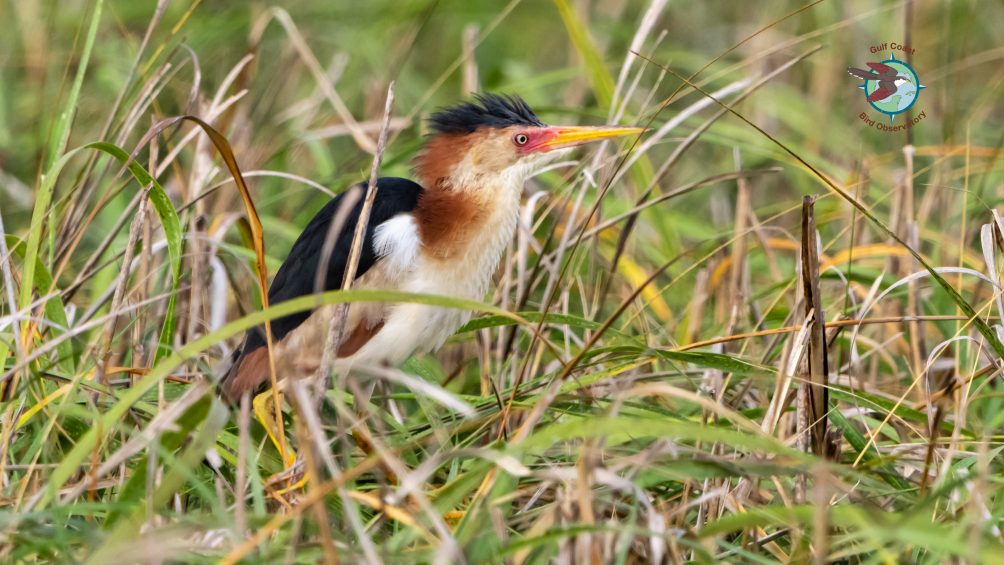Geography/Habitat:
In Texas, Least Bittern (Ixobrychus exilis) is common summer resident along the Coastal Prairies and the eastern portion of the Lower Rio Grande Valley. Inland, they are rare to locally common in the eastern third of the state. In the western portion of the state, it is a very rare and local summer resident due to lack of habitat. During the winter, a few may stay as a winter resident in the Coastal Prairies. Early spring migrants begin arriving by late March and by late October they have migrated south for the winter. Least Bitterns can be found across the eastern half of the United States as well as in isolated areas of the West which have good habitat. They nest in freshwater and brackish marshes with tall aquatic vegetation such as cattails and other reeds and rushes, preferentially in places interspersed with patches of open water and small stands of woody vegetation. Least Bitterns eat mainly small fish such as minnows, sunfishes, and perches. They also eat small snakes, frogs, tadpoles, salamanders, slugs, crayfish, other crustaceans, shrews, mice, dragonflies, and leeches. Their ability to work the reeds allows them to feed in water deeper than that utilized by many of the egrets and herons. Least Bitterns typically hunt alone while perched at the edge of a stand of reeds, watching for prey. Their movements are slow and deliberate when walking or climbing, and they frequently grasp reeds with their feet when moving about above the ground.
Identification:
Least Bittern is a member of the Ardeidae Family (Bitterns, Herons, and Egrets) that is comprised of twenty species in the American Birding Association area. Least Bittern is identified by its overall pale yellow-buff coloration with a black cap and black back. The shoulder has a white line and the throat is lighter with buff colored stripes. The eye, bill, and legs are yellow. While in flight, the remiges appear to be dark and the coverts a bright buffy color. Typical weight is 2.8 oz. or 80 grams. They are frequently located by their song which is a low “coo-coo-coo”. Their call is a low “Grah-ah-ah”.
Interesting Facts:
- When alarmed, the Least Bittern will freeze with its bill pointing up, turning both eyes toward the source of alarm, and may sway to resemble windblown marsh vegetation.
- John James Audubon noted that a young captive Least Bittern was able to walk with ease in a 1.5-inch gap between two books, even though the bird’s body normally measured 2.25 inches across—indicating that it could compress its body to an extraordinary degree to squeeze between marsh stems and reeds.
- A very rare dark form of Least Bittern, known as “Cory’s Least Bittern,” was once considered a separate species. With a black bill, entirely black back, and rich chestnut cheeks, belly, and wing coverts, this distinctive bird was highly prized by bird “collectors” as soon as it was discovered in Florida in 1885. Cory’s Least Bitterns were seen frequently around the Great Lakes, especially around Toronto, in the late 1800s, before its favored marshes were destroyed. Only 7 or 8 records of this mysterious bird are known worldwide since 1973.
- As in many other small herons, Least Bittern’s loral area (between bill and eye) is unfeathered, and this skin can change colors, depending on what the bird is doing. During courtship, copulation, or territorial conflict, the normally yellowish skin can flush brilliant cherry red in males—a sight worth watching for in spring and summer.
- A group of bitterns is known as a “dash”, “freeze”, “pint”, “pretense”, and “siege” of bitterns.
- Least Bitterns occasionally turn up far away from their usual range and habitat. In September 2007, for instance, a migrant was found at Vila do Porto, Azores, in the middle of the Atlantic Ocean.
- Research on breeding Least Bitterns in western New York found the birds used about 24 acres while feeding themselves and their offspring—about the area of 10 city blocks.

